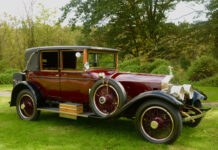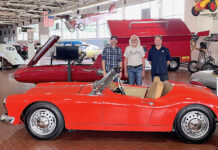By Jay Hirsch
Most new cars leave the factory on giant transport trucks, which is an industry onto itself. One of the pioneers in that business was Gene Cassaroll of Detroit.
During WWII Cassaroll had a contract with the government to transport huge bomber fuselages. For this work he devised a truck with two engines using mostly Dodge parts. From the use of two engines came the name Dual Motors.
Cassaroll, being a car guy, had a vision of a personal luxury-type car for the American car market in the late 1950s, based loosely on the early 1950s show cars of Dodge, the Fire Arrow and Firebomb. Cassaroll contacted Ghia Auto Body works in Turin, Italy, to make this vision into reality. Cassaroll hired Paul Farrago, from Detroit, to rework the two-seat Fire Arrow into the car that could hold some friends or family members. Farrago was an Italian-born mechanic, stylist, and race car driver.
The cars were to be based on the Dodge Chassis with a D-500 engine. The chassis were sent to Turin where the main frame was cut according to the engineered specifications of Cassaroll.
The custom-bodied cars were then sent back to Detroit where the engine and drive-train, the interior trim, and all power accessories were added to the car. The car had a price of $7,600. In 1957 this was a high price for a car with no proven background. A Cadillac or Lincoln convertible was about $5,300. Production was halted in 1958 with 117 cars produced — all but two were convertibles. The cars were sold mainly to Hollywood celebrities. Among owners of the 1957–1958 Dual Ghia’s were Frank Sinatra, Peter Lawford, Lucille Ball, and Ronald Reagan.
In 1961 Casserole decided to revive the Ghia. The difference this time being the car was produced entirely in Italy in hopes of reducing the cost and expenses of shipping the chassis to Italy and then having it shipped back to Detroit to be fitted out mechanically.
Another reason why the Ghia was now made entirely in Italy was that in 1960 all Dodge and Chryslers vehicles were unit body cars, as opposed to a chassis on separate frame automobile. This engineering made it almost impossible to send a chassis to Turin, Italy, to have a custom body installed upon the frame. Though much of the original Dual Ghia design features were incorporated into the new Ghia.
The next generation Dual Ghia, 1961–1963, called simply Ghia, received a minor face lift. The rear tail fin was eliminated and the parking lights were mounted inside of the grill, adjacent to the headlights. The front and rear bumpers became more slender, and the Ghia had minimal amounts of chrome that had did not serve a function.
The 1961 Ghia model is commonly known as the L6.4, as it was powered by Chrysler’s OHV V-8 383 cubic-inch/6.3-liter engine with 2-4 bbls. The car was offered as a hardtop coupe only, as seen here.
The 1961 Ghia weighed in a 4,000 pounds, was rear-wheel drive, and the 383 V-8, rated at 335 hp, was mated to a Torque Flite three-speed automatic. The Ghia rides on 7.10 x 15 tires, is 210 inches long, 75 inches wide and 52 inches in height — which is more in line with some new luxury performance cars than an early 1960s American cruiser. Torsion bars were used in the front with leaf springs in the rear.
To put the price of $15,000 for the Ghia in perspective, in 1961 the average cost of a home was $12,500, the average cost of a new car was $2,850, and gas was 27 cents a gallon.
Michael, who owns this Ghia, “likes all cars” but has a penchant for low production, custom-built, sporty-type cars of the 1950s and early 1960s. Michael also has a preference for the wide white walls which were used on cars in the 1950s and started to be fazed out in 1961 on many new cars. By 1963 all American cars now had the narrow one inch white wall or black wall tires when new. Wide white walls were not in vogue any longer.
As for the ride, the Ghia is more modern than a car that is almost 60 years old. With its low height, 383 cid V-8, and torsion bar suspension, the car is right at home on any highway cruising at 75 to 80 mph. The Ghia has Girling disc brakes in front with drum brakes in the rear, so stopping the 4,000 pound car is not a problem as compared to pre-1970 cars that had drum brakes at all four wheels. The Connolly hide leather seats are soft to the touch and firm when sitting in them. This Ghia is an original car with just minor engine work done — water pump rebuilt, the transmission resealed due to the aging of rubber components, battery replacement, and normal maintenance as needed.
The Ghia holds four very comfortably in those leather wrapped seats, and visibility is excellent for the driver with a windshield that is not sloped at an extreme angle, which puts the header of the windshield directly in front of your eyes.
The occupants have the vast expanse of glass to look out onto the passing scenery without craning their necks and there is room in the trunk for a week’s worth of luggage/bags for four people.
In hopes of making a profit this time around, the price of the 1961 Ghia was now $15,000, which did not help in the marketing of the car. Problems also began to rise at Turin, and overhead costs continued to soar. Production was halted in 1963 with just 26 cars being produced.
In a late 1950s Dell’s New Guide a description of the Ghia ends with “we predict that this car will be the forerunner of many new ideas in fine cars.”
The Ghia was about 45 years too early. •



